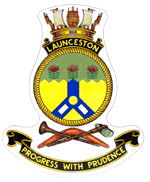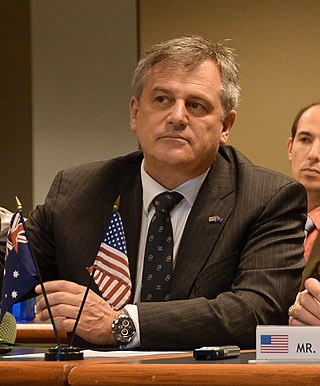Related Research Articles

The Royal Australian Navy (RAN) is the naval branch of the Australian Defence Force (ADF). The professional head of the RAN is Chief of Navy (CN) Vice Admiral Mark Hammond AM, RAN. The Chief of Navy is also jointly responsible to the Minister for Defence (MINDEF) and the Chief of the Defence Force (CDF). The Department of Defence, which is a part of the Australian Public Service, administers the ADF, and ergo, the Royal Australian Navy. In 2023, the Surface Fleet Review was introduced to outline the future of the Navy.

HMAS Burnie (J198/B238/A112), named for the city of Burnie, Tasmania, was one of 60 Bathurst class corvettes constructed during World War II and one of 20 built for the Admiralty but manned by personnel of and commissioned into the Royal Australian Navy (RAN).

HMAS Deloraine (J232/M232), named for the town of Deloraine, Tasmania, was one of 60 Bathurst-class corvettes constructed during World War II, and one of 36 initially manned and commissioned solely by the Royal Australian Navy (RAN). In January 1942 she evaded an attack by the Japanese submarine I-124 north-west of Darwin and was jointly credited with the submarine's sinking after inflicting the initial damage. She was present at the bombing of Darwin and survived unscathed.

HMAS Latrobe (J234/M234), named for the town of Latrobe, Tasmania, was one of 60 Bathurst-class corvettes constructed during World War II, and one of 36 initially manned and commissioned solely by the Royal Australian Navy (RAN).

HMAS Strahan (J363/M363), named for the town of Strahan, Tasmania, was one of 60 Bathurst-class corvettes constructed during World War II, and one of 36 initially manned and commissioned solely by the Royal Australian Navy (RAN).

The Collins-class submarines are Australian-built diesel-electric submarines operated by the Royal Australian Navy (RAN). The Collins class takes its name from Australian Vice Admiral John Augustine Collins; each of the six submarines is named after significant RAN personnel who distinguished themselves in action during World War II. The six vessels were the first submarines built in Australia, prompting widespread improvements in Australian industry and delivering a sovereign sustainment/maintenance capability.
The Defence Science and Technology Group (DSTG) is a part of the Australian Department of Defence, which provides science and technology support to Defence and defence industry. The agency's name was changed from Defence Science and Technology Organisation (DSTO) on 1 July 2015. It is Australia's second largest government-funded science organisation after the CSIRO and its research outcomes have supported operations for over 100 years.

ASC Pty Ltd, formerly the Australian Submarine Corporation and also known as the Australian Shipbuilding Company, is an Australian government business enterprise involved with Australian naval shipbuilding, headquartered in Osborne, South Australia. It is notable for building and maintaining the Collins-class submarine fleet for the Royal Australian Navy (RAN) and for building three Hobart-class destroyers for the RAN, with the first delivered in mid-2017.

HMAS Warrnambool (J202), named for the city of Warrnambool, Victoria was one of 60 Bathurst-class corvettes constructed during World War II, and one of 36 initially manned and commissioned solely by the Royal Australian Navy (RAN). Warrnambool sank after she hit a mine in the Great Barrier Reef on 13 September 1947. She was one of only four Bathurst class corvettes lost while in Australian service, and the only one lost after World War II.

The Royal Australian Navy Submarine Service is the submarine element of the Royal Australian Navy. The service currently forms the Navy's Submarine Force Element Group (FEG) and consists of six Collins class submarines.

HMAS Protector was a Royal Australian Navy (RAN) trials and submarine rescue ship. Built in 1984, the ship was initially operated by the National Safety Council of Australia as MV Blue Nabilla. She was purchased by the RAN in 1990 for use as a surveillance, training, and diving support vessel. During her military career, Protector supported the trials of the Collins-class submarines, and was involved in a search for the shipwreck of the World War II cruiser HMAS Sydney. The ship was decommissioned in 1998 and, while still owned by the Commonwealth, she is provided to Defence Maritime Services to allow them to support Navy activities under contract. Renamed Seahorse Horizon, the ship is operated by Defence Maritime Services out of HMAS Creswell as a training and Fleet support vessel.

HMAS Bunbury (J241/M241), named for the city of Bunbury, Western Australia, was one of 60 Bathurst-class corvettes constructed during World War II, and one of 36 initially manned and commissioned solely by the Royal Australian Navy (RAN).

HMAS Launceston (J179/B246/A120), named for the city of Launceston, Tasmania, was one of 60 Bathurst-class corvettes constructed during World War II and one of 20 built for the Admiralty but manned by personnel of and commissioned into the Royal Australian Navy (RAN).
John Riley is an Australian scientist at the Defence Science and Technology Organisation and former Australian rules footballer who played with Footscray in the Victorian Football League (VFL) and North Adelaide in the South Australian National Football League (SANFL).

Alexander Zelinsky is an Australian computer scientist, systems engineer and roboticist. His career spans innovation, science and technology, research and development, commercial start-ups and education. Professor Zelinsky is Vice-chancellor and President of the University of Newcastle joining the university in November 2018. He was the Chief Defence Scientist of Australia from March 2012 until November 2018. As Chief Defence Scientist he led defence science and technology for Australia's Department of Defence.

Tanya Mary Monro is an Australian physicist known for her work in photonics. She has been Australia's Chief Defence Scientist since 8 March 2019. Prior to that she was the Deputy Vice Chancellor, Research and Innovation (DVCR&I) at the University of South Australia. She was awarded the ARC Georgina Sweet Australian Laureate Fellowship in 2013. She was the inaugural director of the Institute for Photonics & Advanced Sensing (IPAS). Monro has remained an adjunct professor of physics at the University of Adelaide following her departure from the institution. In 2020 she was awarded the title of Emeritus Professor at the University of South Australia.
The 2018 Australia Day Honours are appointments to various orders and honours to recognise and reward good works by Australian citizens. The list was announced on 26 January 2018 by the Governor General of Australia, Sir Peter Cosgrove.

Vice Admiral Jonathan Dallas Mead, is a senior officer in the Royal Australian Navy. He joined the navy via the Royal Australian Naval College at HMAS Creswell in 1984, and spent his early career with the Clearance Diving Branch before training as a Principal Warfare Officer. He captained HMAS Parramatta on operations in the Persian Gulf from 2006 to 2007 during the Iraq War and commanded Combined Task Force 150, overseeing maritime counter-terrorism operations around the Arabian Peninsula and Horn of Africa, from 2011 to 2012. He served as Head of Navy Capability from 2015 to 2017, Commander Australian Fleet from 2018 to 2020, Chief of Joint Capabilities from 2020 to 2021, and was appointed Chief of the Nuclear-Powered Submarine Task Force in September 2021.
The 2020 Australia Day Honours are appointments to various orders and honours to recognise and reward good works by Australian citizens. The list was announced on 26 January 2020 by the Governor General of Australia, David Hurley.

Vice Admiral Mark David Hammond is a senior officer in the Royal Australian Navy (RAN), serving as the Chief of Navy since July 2022. He joined the RAN as an electronics technician in 1986 and, after being accepted for officer training, graduated from the Australian Defence Force Academy in 1990. Much of Hammond's career has been spent in the Submarine Service. He has served on operations in the Indo-Pacific, commanded the Collins-class submarineHMAS Farncomb, was Deputy Chief of Navy from 2018 to 2020, and served as Commander Australian Fleet from November 2020 to June 2022. He succeeded Vice Admiral Michael Noonan as Chief of Navy on 6 July 2022.
References
- ↑ "DR JANIS COCKING TO RETIRE". Partnership Matters. Defence Science and Technology Group. July 2018. Retrieved 30 January 2020.
- 1 2 3 4 "Dr Janis Cocking". Defence Science and Technology Group . Retrieved 13 June 2018.
- ↑ Nicholson, Brendan (11 April 2014). "Cheaper submarines 'risk the lives of sailors'". The Australian. Retrieved 13 June 2018.
- ↑ "Dr Janis Cocking". Collaborate | Innovate | 2018. CRC Association. May 2018. Retrieved 13 June 2018.
- ↑ "DSTO maritime chief awarded honorary degree". University of Tasmania. 25 August 2014. Retrieved 13 June 2018.
- ↑ "Public Service Medal (PSM) entry for COCKING, Janis Louise". Australian Honours Database. Canberra, Australia: Department of the Prime Minister and Cabinet. 11 June 2018. Retrieved 13 June 2018.
For outstanding public service to Defence science and technology